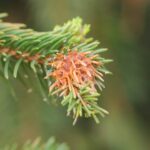Spruce Needleminer
Leafminers & Needleminers
Spruce Needleminer (Lochmaeus pinus) is a type of sawfly that feeds on the needles of spruce trees. The larvae of the spruce needleminer create characteristic serpentine mines that can be seen along the length of the needles. These mines can become so numerous that entire spruce trees can be defoliated, making the trees look yellow or brown.
Spruce needleminers primarily affect Norway spruce and Colorado blue spruce, although other species of spruce may also be impacted. The pests are most damaging in young, fast-growing trees and in areas with high populations of the insects.
The adult female spruce needleminer lays eggs along the length of the needles. When the eggs hatch, the larvae feed on the inner tissue of the needles, creating the characteristic serpentine mines. The larvae then pupate within the mines and emerge as adult sawflies in the spring.
Damage from spruce needleminers can be mitigated through proper cultural practices, including maintaining the health of the tree, removing infested needles, and avoiding stress on the tree. Chemical control may also be used, although it is best to apply insecticides in early spring, when the larvae are small and most vulnerable.
In severe cases, the repeated defoliation from spruce needleminers can weaken or kill the tree, making it important to monitor for and manage this pest in order to maintain the health of spruce trees.



